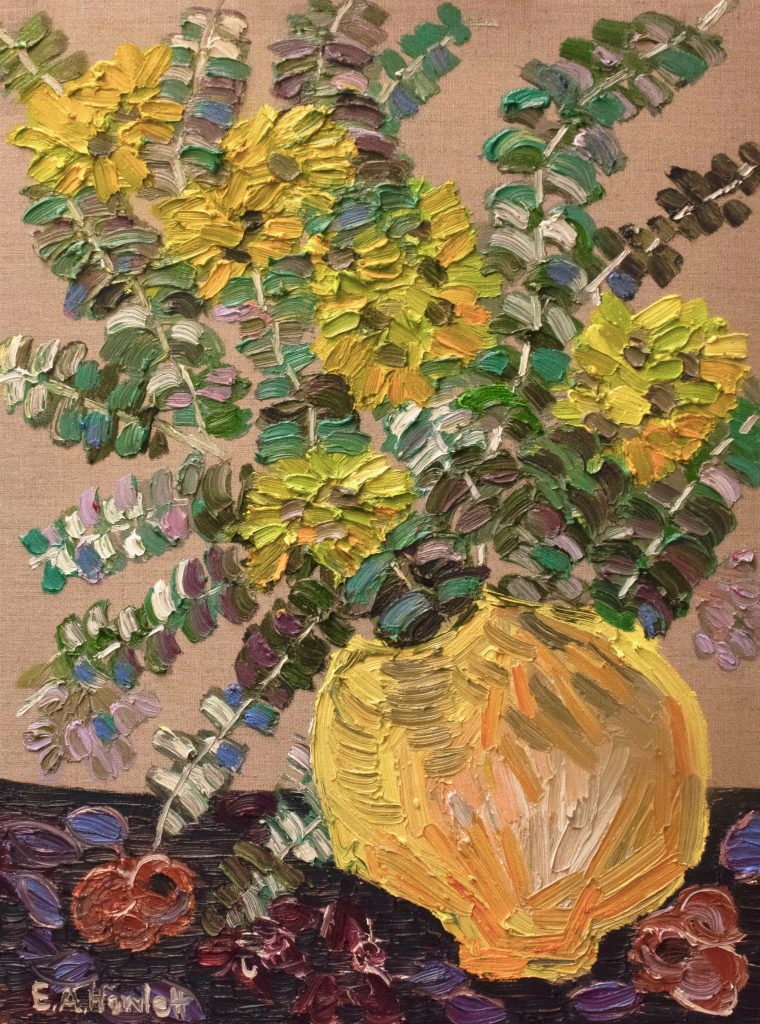Each part of the process of making a painting is important to me. Even though the earlier stages are covered by the final layer of thick oil paint. I have a lot of resource material and references at the ready to help me decide what to paint next. Which brings me to the initial question, what am I going to paint? More recently I have been painting in series of works. This is one of the most satisfying approaches I have taken to date. Focussing in on a theme, using the same vase with multiple bouquets, or referencing the floristry of an Australian florist. Mostly though, I paint my own sculptural floral creations.
WHAT SHALL I PAINT?
The first step in my process is deciding what to paint. I will collect some native flowers or some roses, and then present them in the way I may wish to paint them, for example, in a vase. I photograph a subject loads of times, in varying locations. This helps me to decide on a composition. As I have quite a few finalised images to choose from, there are often several choices. I enjoy working this way, as I have multiple options to consider.

A good example of flowers photographed for composition purposes
…
DRAWING ONTO CANVAS

A good example of a charcoal drawing on canvas.
Once I have decided on my composition, the first step towards producing a painting is to draw. A lot of drawing and shaping of lines is done with the gum eraser for charcoal. I draw directly onto the canvas or linen. I do this via 3 approaches, (or a combination of these):
- Drawing with paint. I enjoy painting directly from life. Painting directly in oil “at first attempt’, is called Alla Prima. Wet paint is applied into wet.
- Other times I will draw the flowers as they appear in front of me, from life, directly onto the canvas. I will have the flowers set up in a vase in my studio.
- For much of my practice I make a drawing by enlarging a photograph. I make a photograph of what my mind’s eye wants to paint. This is part of the seeing the way an artist sees. A grid is placed over the photograph and a larger grid is placed on the canvas. The ratios of image and canvas must be the same.

…

Flowers are drawn from life in my studio directly onto canvas

Final drawing in willow charcoal before underpainting
UNDERPAINTING
If I have drawn in charcoal, the next step in my process is to to an under-painting. I use watery acrylic to paint the shapes, including the background, in the colours I intend to use for the final painting. This is a fairly relaxed stage. It is however, the stage where a lot of decisions are made. I consider this my map to paint in oil.

Underpainting in washy acrylic onto the canvas
OIL PAINTING
This is the fun bit. Once I have my map, I paint in oil. I am an impasto oil painter, and I paint with a brush, and sometimes a painting knife. I thicken my paint with impasto medium, which also causes the oil paint to dry more quickly, once it’s on the canvas. I generally do one layer in oil. I apply the paint thickly and deliberately. This is where the right brain kicks in, as I do not “think” with my left brain a lot during this stage. There is a saying “don’t think, just paint”, which rings true. I love this stage. It is very life giving. It gives me joy.

Final work, “The Blue Jug” oil on canvas, 60 x 60 cm
PROGRESSION OF A WORK
An example of where a grid is drawn to enlarge an image.

Charcoal drawing of Lillypilly Dance showing grid
…

Underpainting of Lillypilly Dance
…

Lillypilly Dance, oil on canvas, 100 x 100cm